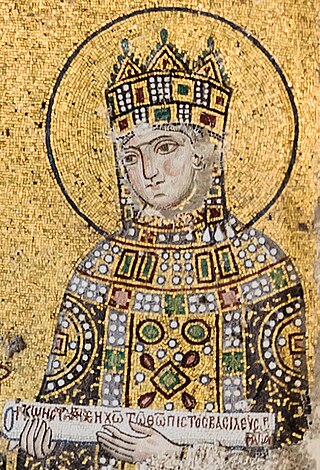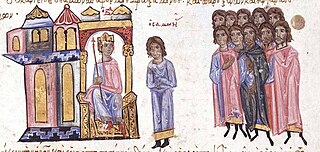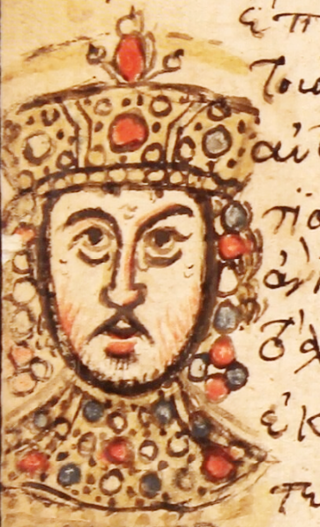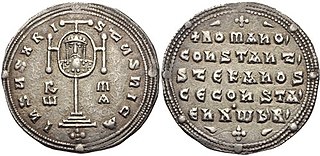
Constantine VIII (Greek: Κωνσταντῖνος, Kōnstantinos; 960 – 11/12 November 1028) was de jure Byzantine emperor from 962 until his death. He was the younger son of Emperor Romanos II and Empress Theophano. He was nominal co-emperor since 962, successively with his father; stepfather, Nikephoros II Phokas; uncle, John I Tzimiskes; and brother, Basil II. Basil's death in 1025 left Constantine as the sole emperor. He occupied the throne for 66 years in total, making him de jure the longest-reigning amongst all Roman emperors since Augustus.

Basil I, nicknamed "the Macedonian", was Byzantine emperor from 867 to 886. Born to a peasant family in Macedonia, he rose to prominence in the imperial court after gaining the favour of Emperor Michael III, whose mistress he married on his emperor's orders. In 866, Michael proclaimed him co-emperor. Fearing a loss of influence, Basil orchestrated Michael's assassination the next year and installed himself as sole ruler of the empire. He was the first ruler of the Macedonian dynasty.

Romanos I Lakapenos or Lekapenos, Latinized as Romanus I Lecapenus, was Byzantine emperor from 920 until his deposition in 944, serving as regent for and senior co-ruler of the young Constantine VII.

Zoe Porphyrogenita was a member of the Macedonian dynasty who briefly reigned as Byzantine empress in 1042, alongside her sister Theodora. Before that she was enthroned as empress consort or empress mother to a series of co-rulers, two of whom were married to her.

Leo VI, also known as Leothe Wise, was Byzantine Emperor from 886 to 912. The second ruler of the Macedonian dynasty, he was very well read, leading to his epithet. During his reign, the renaissance of letters, begun by his predecessor Basil I, continued; but the empire also saw several military defeats in the Balkans against Bulgaria and against the Arabs in Sicily and the Aegean. His reign also witnessed the formal discontinuation of several ancient Roman institutions, such as the separate office of Roman consul.

Constantine VII Porphyrogenitus was the fourth Byzantine emperor of the Macedonian dynasty, reigning from 6 June 913 to 9 November 959. He was the son of Emperor Leo VI and his fourth wife, Zoe Karbonopsina, and the nephew of his predecessor Alexander.
This is an alphabetical index of people, places, things, and concepts related to or originating from the Byzantine Empire. Feel free to add more, and create missing pages. You can track changes to the articles included in this list from here.

The Macedonian dynasty ruled the Byzantine Empire from 867 to 1056, following the Amorian dynasty. During this period, the Byzantine state reached its greatest extent since the Early Muslim conquests, and the Macedonian Renaissance in letters and arts began. The dynasty was named after its founder, Basil I the Macedonian who came from the theme of Macedonia.
Leo Phokas was an early 10th-century Byzantine general of the noble Phokas clan. As Domestic of the Schools, the Byzantine army's commander-in-chief, he led a large-scale campaign against the Bulgarians in 917, but was heavily defeated at the battles of Acheloos and Katasyrtai. He then plotted to seize the throne from the young Byzantine emperor Constantine VII, but was outmaneuvered by the admiral Romanos Lekapenos, who managed to become guardian and later father-in-law of the Emperor. After Lekapenos seized control of the Byzantine Empire, Leo led an unsuccessful revolt, and was captured and blinded.
The parakoimōmenos was a Byzantine court position, usually reserved for eunuchs. The position's proximity to the emperors guaranteed its holders influence and power, and many of them, especially in the 9th and 10th centuries, functioned as the Byzantine Empire's chief ministers.
Stylianos Zaoutzes was a high Byzantine official of Armenian origin. Rising to high rank under Byzantine emperor Basil I, he then rose further to prominence under Basil's successor Emperor Leo VI the Wise, who had a close friendship and possibly an affair with Stylianos's daughter Zoe Zaoutzaina. Stylianos Zaoutzes was Leo's leading minister during the first half of his reign, and was awarded the unique title of basileopator. His standing and influence declined after 895, but in 898, he became Leo's father-in-law when the Byzantine emperor married Zoe. He died in 899, in the same year as Zoe. Following an attempted coup by his relatives, the Zaoutzes clan was deprived of the considerable power it had amassed under Stylianos's tutelage.

Samonas was an Arab eunuch, who was captured by the Byzantines and became one of the most influential officials of the Byzantine Empire during the first decade of the 10th century.

Constantine Doukas was a prominent Byzantine general. In 904, he stopped the influential eunuch court official Samonas from defecting to the Arabs. In return, Samonas manipulated his father, Andronikos Doukas, into rebelling and fleeing to the Abbasid court in 906/7. Constantine followed his father to Baghdad, but soon escaped and returned to Byzantium, where he was restored by Leo VI the Wise to favour and entrusted with high military offices. Upon the death of the Emperor Alexander, Constantine with the support of several aristocrats unsuccessfully tried to usurp the throne from the young Constantine VII, but was killed in a clash with supporters of the legitimate emperor.

Christopher Lekapenos or Lecapenus was the eldest son of Emperor Romanos I Lekapenos and co-emperor of the Byzantine Empire from 921 until his death in 931. Christopher was given the position of megas hetaireiarches in spring 919, after Romanos assumed guardianship of the underage Emperor Constantine VII. Romanos, who had made himself emperor in 920, raised Christopher to co-emperor on 21 May 921 in order to give his family precedence over Constantine VII's Macedonian line. In 928 Christopher's father-in-law, Niketas, unsuccessfully attempted to incite Christopher to usurp his father, resulting in Niketas being banished. Christopher died in August 931, succeeded by his father and two brothers, Stephen Lekapenos and Constantine Lekapenos, and Constantine VII. In December 944 his brothers overthrew and exiled their father, but they themselves were exiled after attempting to oust Constantine VII.

Stephen Lekapenos or Lecapenus was the second son of the Byzantine emperor Romanos I Lekapenos, and co-emperor from 924 to 945. With his younger brother Constantine, he deposed Romanos I in December 944, but was overthrown and exiled by the legitimate emperor Constantine VII a few weeks later. Stephen lived out his life in exile on the island of Lesbos, where he died on Easter 963.

Constantine Lekapenos or Lecapenus was the third son of the Byzantine emperor Romanos I Lekapenos, and co-emperor from 924 to 945. With his elder brother Stephen, he deposed Romanos I in December 944, but was overthrown and exiled by the legitimate emperor Constantine VII a few weeks later. Constantine Lekapenos was exiled to the island of Samothrace, where he was killed while attempting to escape sometime between 946 and 948.
Constantine Gongyles was a Byzantine eunuch and court official who led a failed expedition against the Emirate of Crete in 949.
Constantine, surnamed Barbaros, was a Byzantine eunuch servant who rose to become parakoimomenos of the Byzantine emperor Leo VI the Wise in 911–912, displacing his own former master, Samonas. He held again the post during the regency of Zoe Karbonopsina in 913–919, where he played an important role in the governance of the state. He lost his post after he supported his relative Leo Phokas the Elder in his unsuccessful rivalry with Romanos I Lekapenos over control of the throne, but he was later appointed to the post of primikerios by Lekapenos.

Lekapenos or Lakapenos (Λακαπηνός), usually Latinized as Lecapenus, feminine form Lekapene (Λεκαπηνή), was the name of a prominent, assumed, Byzantine-Armenian family of humble background which intermarried with and almost managed to usurp the throne from the Macedonian dynasty in the first half of the 10th century.
The Vita Basilii is an anonymous biography of the Emperor Basil I, the first Byzantine emperor of the Macedonian dynasty. It is the second work in the collection known as Theophanes Continuatus. It may have been written around 950 by the emperor's grandson, the Emperor Constantine VII, or perhaps by Theodore Daphnopates.













